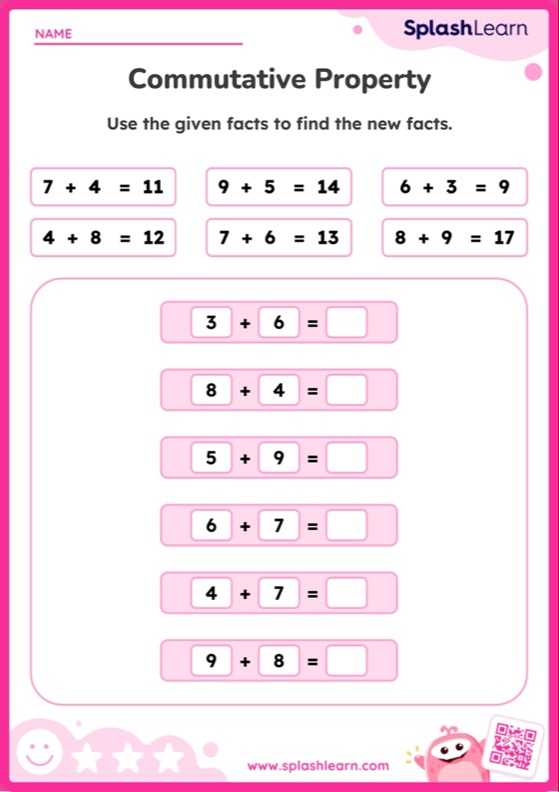What Is the Commutative Property of Multiplication in Math?
Commutative comes from the word “commute”, which can be defined as moving around or traveling. According to the commutative property of multiplication, changing the order of the numbers we are multiplying does not change the product.
Let’s understand this with an example.
Example of Commutative Property of Multiplication
Place 3 bricks in a row.

Now place another row of bricks above this row.

Repeat this process 4 times.

Now count the number of bricks used.

Total bricks $=$ Number of rows $\times$ Number of bricks in each row
$= 4 \times 3$
$= 12$
Now, create a row by placing 4 bricks.

Place two more rows above this row.
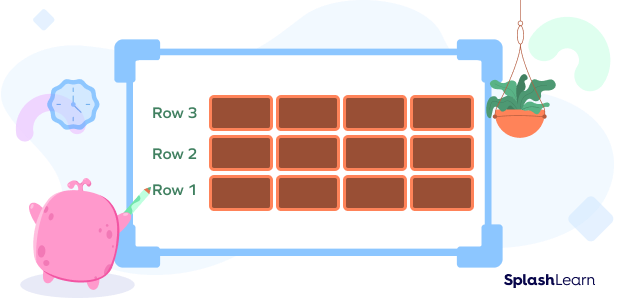
Total bricks $=$ Number of rows $\times$ Number of bricks in each row
$= 3 \times 4$
$= 12$
We have observed that interchanging the number of rows with the number of bricks in each row does not change the total bricks needed.
 Begin here
Begin here
What Is Multiplication?
Multiplication is nothing but repeated addition. It is denoted by ‘*’, ‘.’ and ‘✕’.
Let’s see what is repeated addition with the help of given example:
Example: A monkey is jumping from one point to another. It covers one unit distance with every jump. How many units will it cover in 5 jumps?
Solution: From the above statement, we can say that 1 jump $= 1$ unit. Let’s look at this image.
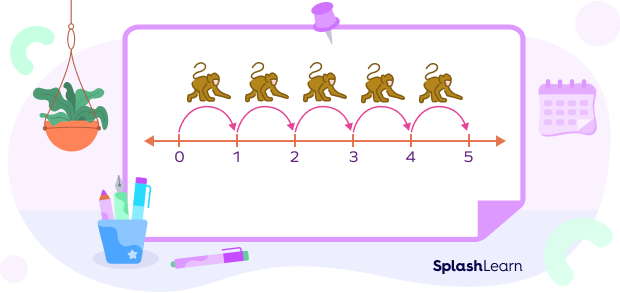
So, we can see that monkey covers $1+1+1+1+1 = 5$ units
We can also write it as $1 \times 5 = 5$ units.
Now, observe that for each step, we need to add “1” in the previous one. That’s why we can say that multiplication is nothing but repeated addition.
Let’s go through another example.
Example: Robin wants to buy 3 bars of chocolate. Each bar costs $\$$ 10. How much money Robin needs to buy 3 bars?
We can solve this problem using two different methods. Let’s look at both methods.

Method 1:
Number of chocolates $\times$ Cost of Each Chocolate
$= 3$ $\times $ $\$$ 10
$=$ $\$$ 30
Method 2 :
Cost of Each Chocolate $\times$ Number of chocolates
$=$ $\$$ 10 $\times$ $3$
$=$ $\$$ 30
We have observed that the order in which we multiplied the number of chocolate bars and cost of each bar does not change the amount required.
Related Worksheets
Commutative Property of Multiplication
You must be familiar with tables up to 5.
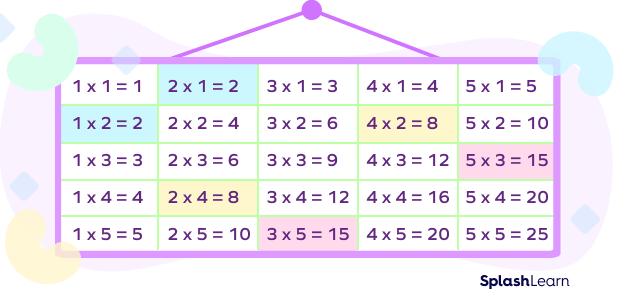
Have you observed
$1 \times 2 = 2 \times 1 = 2$
$2 \times 4 = 4 \times 2 = 8$
$3 \times 5 = 5 \times 3 = 15$
So, we can conclude that the order in which we multiply numbers does not change the final answer.
Do you know?
If you remember tables up to 5, you can figure out the multiplication of bigger tables by using the commutative property.
For example:
If you know
Five times eight, i.e., $5 \times 8 =$ ?
You can also answer
Eight times five, i.e., $8 \times 5 =$ ?
Both are equal to 40.
Fact to Remember
The commutative property applies only to addition and multiplication but not to subtraction and division.
Let’s understand this with examples.
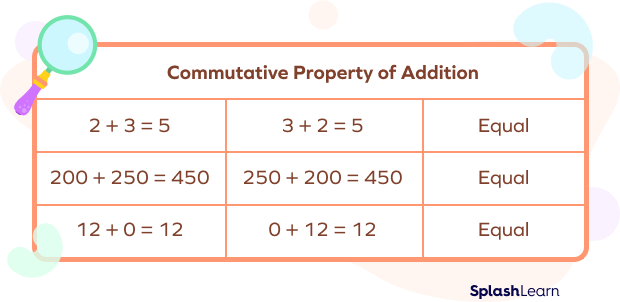
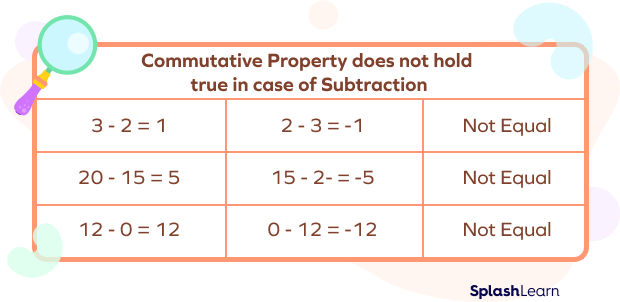
Alt Tag: Commutative Property holds true in case of Multiplication
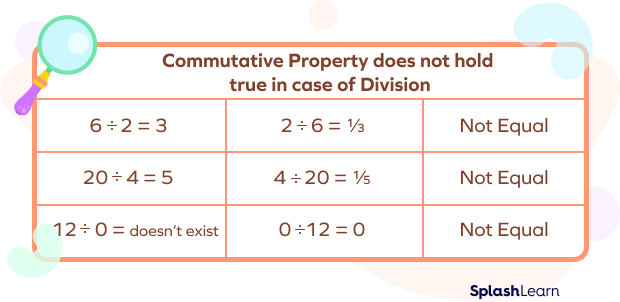
So, we can conclude that commutative property applies to addition and multiplication, not to subtraction and division.
Conclusion
In conclusion, we can say that
- Multiplication is nothing but the repeated addition.
- Commutative property means the end result will not change if we change the order.
- Multiplication and addition follows commutative property.
Solved Examples
Example 1: Fill in the blanks.
- $4 \times 5 = 5 \times \underline{}$
Solution: $4 \times 5 = 5 \times 4$
- $3 \times = 6 \times \underline{}$
Solution: $3 \times \underline{} $6$ \underline{} = 6 \times 3$
- $2 \times 1 = 1 \times \underline{}$
Solution: $2 \times 1 = 1 \times 2$
- $3 \times 6 \times \underline{} = 3 \times 2 \times 6$
Solution: $3 \times 6 \times 2 = 3 \times 2 \times 6$
- $16 \times 2 \times 4 = 2 \times \underline{} \times 4$
Solution: $16 \times 2 \times 4 = 2 \times 16 \times 4$
- $9 \times \underline{} \times 2 = 8 \times \underline{} \times 2$
Solution: $9 \times \underline{} 8 \underline{} \times 2 = 8 \times 9 \times 2$
Example 2: Complete the following statement:
The commutative property says that the order of numbers in _________ and _________ does not change the result.
Solution:
The commutative property says that the order of numbers in multiplication and addition does not change the result.
Only multiplication and addition follow the commutative property.
Practice Problems
Communicative Property of Multiplication - Definition With Examples
Which expression is the same as $6 \times 4 \times 5$ according to the commutative property?
Explanation: According to the commutative property of multiplication, if the order of numbers is changed, the product will remain the same.
A $\times$ B = B $\times$ A is the
Explanation: According to the commutative property of multiplication, if the order of numbers is changed, the product will remain the same.
$A + B = B + A$ is the
Explanation: According to the commutative property of addition, if the order of numbers is changed, the addition will remain the same.
Which expression is the same as $6 + 4 + 5$ according to the commutative property?
Explanation: According to the commutative property of addition, if the order of numbers is changed, the addition will remain the same.
Frequently Asked Questions
Which operations do not follow commutative property?
Subtraction and division do not follow the commutative property.
Can we apply the commutative property for the multiplication of 4 numbers?
Yes, we can apply commutative property for the multiplication of 4 numbers.
For example, $4 \times 5 \times 6 \times 7 = 7 \times 5 \times 6 \times 4$
What is the difference between the associative and commutative property of multiplication?
The associative feature of multiplication asserts that when the grouping of the numbers is altered, the product of the numbers remains the same. $(\text{A B})$ $\text{C} = \text{A}$ $(\text{B C})$ is how the associative property of multiplication is expressed.
The commutative property of multiplication asserts that even if the order of the numbers is changed, the product of two or more integers remains the same. Multiplication’s commutative property is represented as $\text{A B C} = \text{C B A}$.











